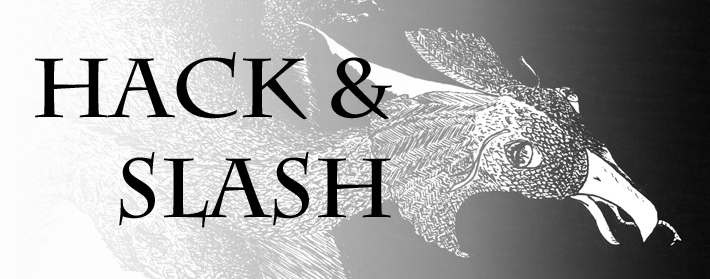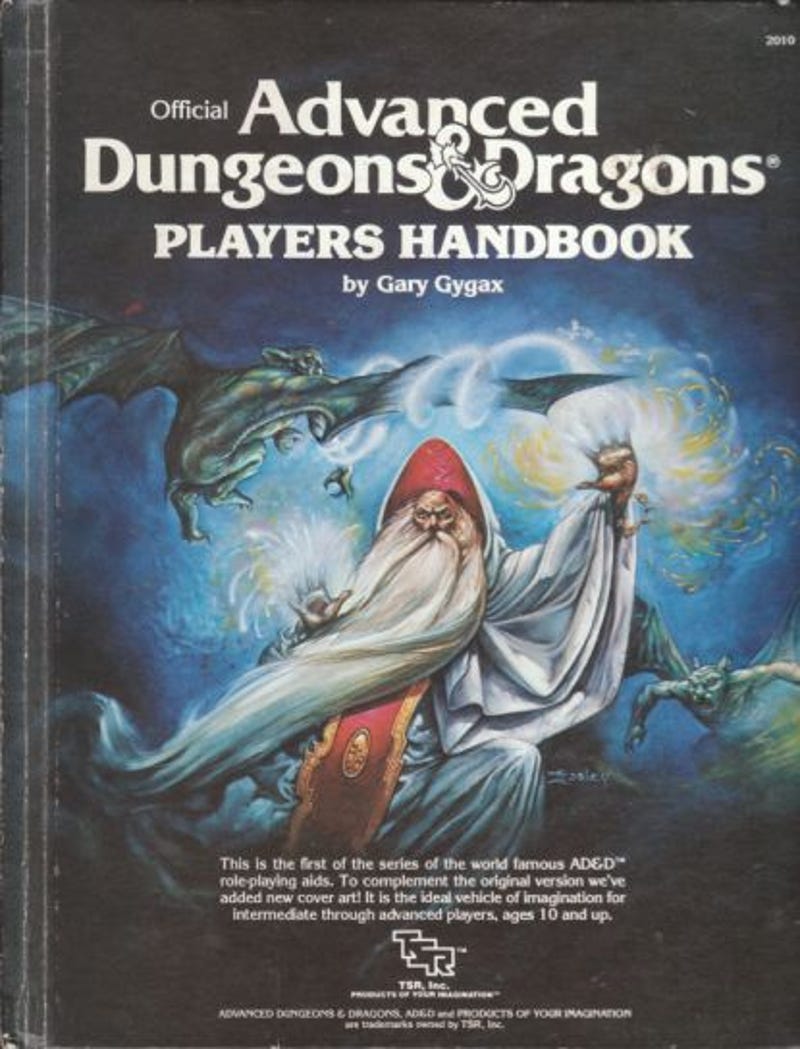Do
you smell that?
It's
the smell of a new campaign. New players, new dynamics, new
adventures!
Here's
how this goes:
Suggest
a couple of games to players a month ahead of time.
Finalize
the game date.
Realize
no one has picked a game.
Players
select the game they want 48 hours before the game.
Hurriedly
design an entire campaign from scratch.
Frantically
try to print off everything you need before the game.
Forget
to print off a bunch of things.
Realize
only after the game starts that all the .pdfs you need to reference
are on the tablet your daughter is using to watch kid's shows.
Bargain
with your daughter for the tablet.
Decide
to use your phone instead.
Give
up on using your phone.
Refer
to things as "That country I made up a name for that I can't
find."
Spend
20 minutes looking for that one piece of paper that has the entire
campaign on it.
Find
it in the folder you made for the players.
Watch
a 5e player's eyes go wide as a critical chart takes off the clerics
arm.
Have
her leave to go smoke.
Convince
your daughter that the phone is better then the tablet.
Hurriedly
try to find the name of that rebel group in the .pdf.
End
the session rolling up new characters.
Beginning a campaign from scratch
I
joke, but this touches on a real issue. Even using an
system with no house rules and an adventure path, there's still a
tremendous amount of work that needs to happen to get a campaign off the ground.
Let's
take a look at what needs to be done, just to start:
- You have to create an area for the players to adventure. You need to populate this area. If you're being a good dungeon master, this area should be able to handle both expansion, foreshadow the course of the campaign, and be thematically interesting.
- You need to decide what races and classes you are going to allow.
- Generally, you have to provide a selection of deities for clerics.
- You have to either select or design a calendar to keep track of time. (YOU CAN NOT HAVE A MEANINGFUL CAMPAIGN IF STRICT TIME RECORDS ARE NOT KEPT.)
- You have to decide what languages are available for the players to learn.
- You need to create a facebook/G+ page and an obsidian portal/wiki as a reference for the campaign as it develops.
How
much work is that already?
Then you have character creation, which even in the
best games, feels like needing to do taxes so you
can get your refund.
There's some person out there, full of more vigor then sense, who
will likely point out that you don't have to do these
things. Sure, you don't have to. You don't have to brush your teeth
in the morning, but who wants to be a damn savage?
The tools have been getting better for this
process over the years. I find starting a campaign from scratch much
easier now–not only because I've written my own tools, but because
there are more useful tools out there.
The process
Because
this is something that's really opaque, I'm going to outline my
process below.
The
very first thing is you get some players interested. I find, these
days, it's as easy as "I'm running a game at date/time,
anyone interested?" I then create a venue on a social
network where these players can all interact.
System
My
next step was to discuss what system we are going to use. No matter
what is picked, there's always issues. I don't like clerics
and find % thief skills obnoxious. 3.5/Pathfinder games you need to
decide what books you are allowing. In this case, the players and I
voted for 1st edition AD&D.
Right
away, my long experience gives me some insight into how this plays
out. Demi-humans are far superior to humans in almost all respects,
and most players end up playing Demi-humans as humans in
funny hats. I make humans mechanically
superior (4d6DL & assign, versus 3d6 in order, switch 2) and add
drawbacks to each race. I used Andrew Shields Death Dwarves and their
meatsmithing, took a bit of the chaos elves and have them all start
with at least one madness, and have half-men (Halflings) have rows
and rows of teeth, who prey on the failing morals of men.
I
also replace the thief with the expert class and change all the thief
skills and secondary skills to use Skills: the Middle Road. I also
inform the players that I will be using my Death & Dismemberment
table, along with Hackmaster Critical hits.
World
I
give a moment's thought to theme. I decide on a frontier style game. Instead of having a foreign land , where
all the cultures are bizarre, I'd prefer a more traditionally
medieval setting. My inspirations include Berserk, the 100 years war,
Artesia, Bladestorm, Romance of the Three Kingdoms, and all the drama
inherent in war.
With the idea that the characters are at a forward outpost
of a despotic country, with conflict brewing with the nearest
city, surrounded by unknown militaristic forces, I
head over to Wizardawn and generate maps until I find one that I
like. Mountains to the north, a few lakes. I generate it sans any
generated sites. I save this map to my Dropbox, print out a color copy and a very light almost faded black and white copy. On the light copy, I create a few cities, about half a dozen towns, and
place resources and obstacles over the map. I don't generate the
content for any of these. Partially because some answers will be
obvious (one city and town on the west side of the map will reflect
the outpost and the nearest settlement) and partially because they will develop in play.
This
map is at a scale of 6 mile hexes, making it about the size of my
home state of Arkansas. The distances are substantial, but not
unmanageable. There's endless adventure inside a single six mile hex, so it provides plenty of room for play and
expansion. I can have a whole ancient empire in just a few hexes or
introduce a new castle or force late in the campaign.
Then
I generate some monster threats. One worldshaker, two that are
formidable opponents for Lord or name level characters, and then four
that are challenges for superhero level characters. Most of the hero
level challenges don't influence the campaign enough to design now.
Now
that all that is written, I rationalize clerics and select a
calendar. I have a few default options, one from a campaign my father
was in way back in the early 80's, another that I designed to be a
unique calendar that I use from time to time. Not having to do this
from scratch is a big time saver.
Preparation
The
next thing is what we will need to start play.
I'm playing 1st edition with hackmaster criticals so armor placement
is important, along with character sheets. I print off a 1st edition
Player's Handbook gear list, and consider printing off some gear
packages, but I've been burned with having differing prices before.
This later turns out to be a mistake, considering exactly how much
gear the players were missing. They had a bullseye lantern no one
could light, and no rope. I print out blank spell lists for
spellcasters, and then I turn to my Binder.
I
find some suitably gory and bizarre images to insert into the covers
of the binder, and begin collecting what I need from online and my
older folders. I need a copy of my "Table for Avoiding Death", some blank paper, a table for random monster behavior, combat
commentary styles, Non-Player Character features, A table for random
hireling traits, random backgrounds for henchmen (which will
partially decide their class when they acquire enough experience to
level), and a list of completely random rumors, which is often useful
for inspiration.
The
next section contains a cheat sheet for 1e morale, evasion, and
encounter detection and a table of 100 reasons the characters are
together along with a list of totally bullshit taxes that can be
levied on players. The 100 reasons sheet is extremely useful for
creating emergent play.
Finally,
I have a section devoted to overland travel. The first page is a way
to determine with one die roll when the next encounter is based on
encounter frequency, instead of having to roll three, four, or even
six or more times per day of travel. Then I have several lists of
non-standard wilderness events, some creative tables for merchants,
war travel, short encounters, unique treasure, holidays, strange
inns, etc. Then I have a page devoted to an article from a
hackjournal that contains a random system for naming small villages
and hamlets. Finally I have a copy of the d30 random wilderness book.
Adventure
Well,
what now?
There's
still a lot left to do. Like what are the players actually going to
do when they get to the game? I generate three key Non-Player Characters, and an opening
setting for their arrival in town. I also go through the various
books and monster manuals (The Creature Compendium, Fire on theVelvet Horizon, etc.) and pick a small (2-6) selection of monsters
per terrain type near the starting area. These will be the primary
antagonists and animals the players will meet.
Due
to time constraints, I forgo creating an actual wandering monster
table. In order to create an actual experience of discovery and
realism, I follow the method for monster tables outlined on the
retired adventurer blog, each containing spoors, lairs, and other
monster sign.
I
then flip through some resources, looking for a few activities for
new adventurers, along with ideas for other local factions and
groups. I select a few from here and there, and write them down on my
campaign sheet, which at this point is still a single piece of paper
with a lot of writing on it. I grab a copy of a few interesting
files, and dump them on my tablet.
Then
I gather the books I need. My "On the Non-Player Character",
Delta's "Book of War", Crawford's "An Echo, Resounding", My
1e Dungeon Master Screen, Dungeon Master's Guide, and Player's
Handbook, A copy of "Dyson's Delves" for treasure maps. I
also keep a copy of my Critical Hit/Wild Magic Resource, and
Kellri's CCD:4 for wilderness travel nearby.
I
gather dice, pencils, dice trays, my tact-tiles, dry erase markers,
buy a fruit tray, and just hope for the best at this point.
The Beginning
Well,
after you had the first game session, that's it eh?
Not
hardly. Then comes setting up the Obsidian Portal, drawing pictures
of the non-player characters, creating new non-player characters,
writing the random tables, creating interesting and connected rumors,
and more.
In
2017, I was able to handle all the above in about 48 hours, whereas
as short as a decade ago it could take weeks, or more. Are we there yet? We are getting better. Newer
rulesets like ACKS, DCC, and Perdition require a lot less
house-ruling of core systems it seems; adventurers, tools, and
resources seem to be getting more useful as time goes on. Even the
quality of official material seems to be of a higher caliber (but
often fails from trying to be too many things to too many people).
What
about your campaigns? Is every single one a task of pulling the
entire world up by its bootstraps while you are astride it?
If you like posts like this, support me on Patreon!

